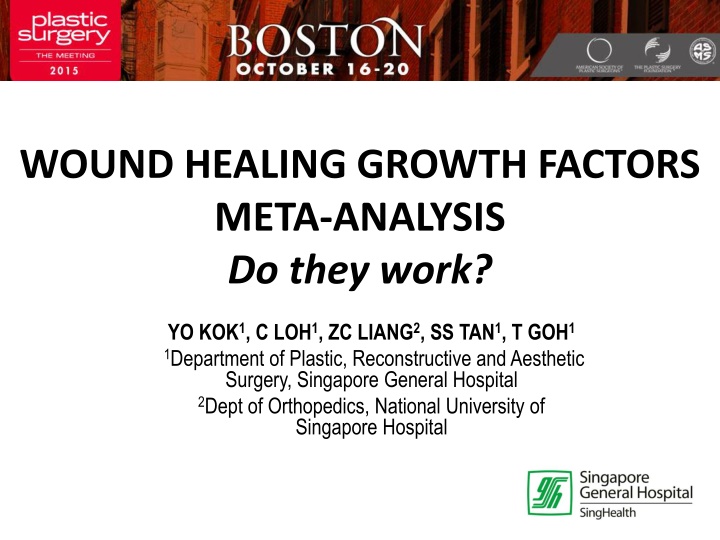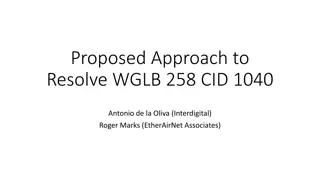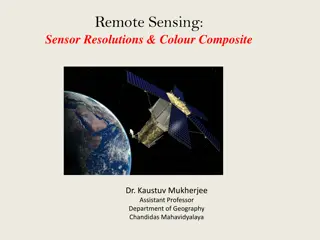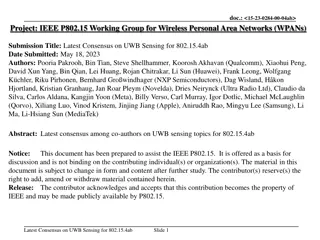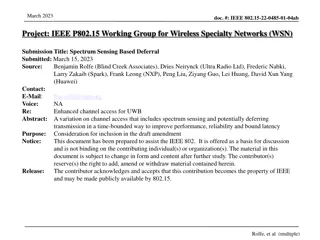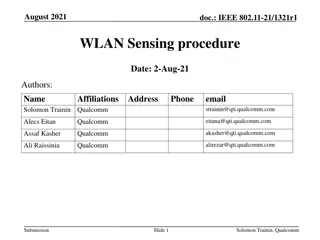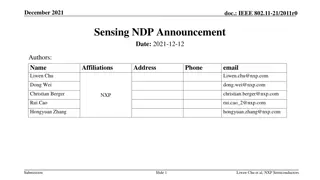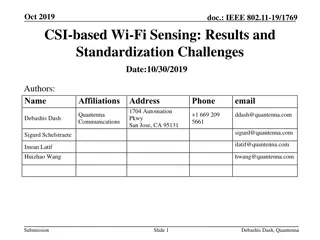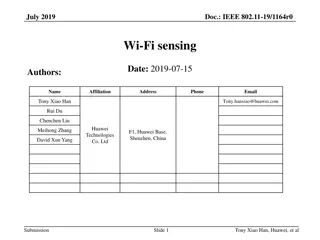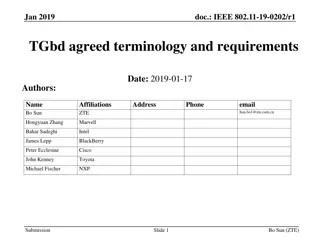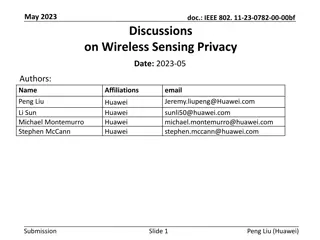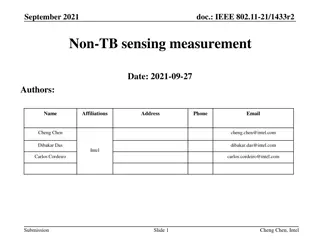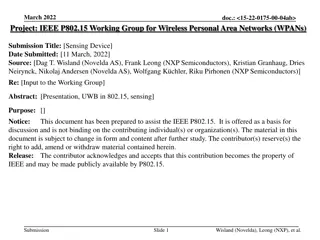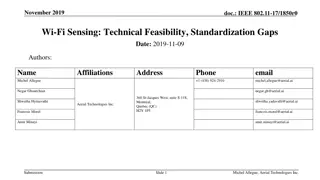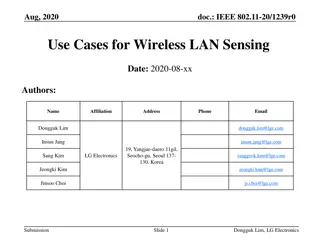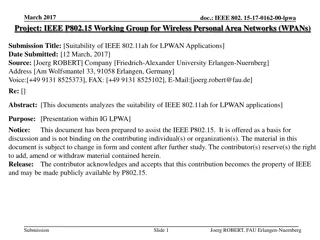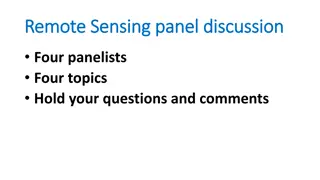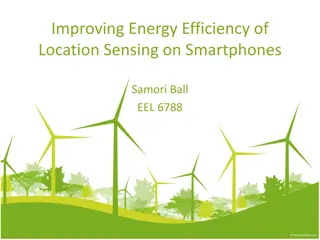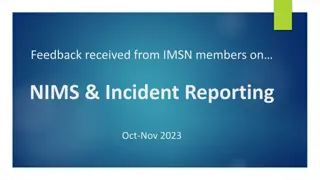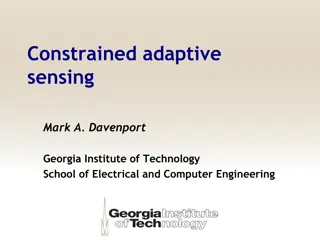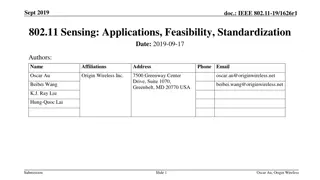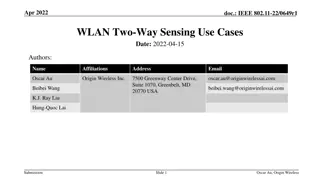Sensing Procedure Reporting in IEEE 802.11-22
This document discusses the reporting aspects of Sensing by Proxy (SBP) procedures in IEEE 802.11-22 standard. It addresses issues related to the frequency of sensing measurement reports, determination of reporting frequency, timestamp usage, and threshold-based reporting. The content explores challenges in consistent CSI measurements over time and selection of non-AP STAs for participation in sensing measurements.
Download Presentation

Please find below an Image/Link to download the presentation.
The content on the website is provided AS IS for your information and personal use only. It may not be sold, licensed, or shared on other websites without obtaining consent from the author.If you encounter any issues during the download, it is possible that the publisher has removed the file from their server.
You are allowed to download the files provided on this website for personal or commercial use, subject to the condition that they are used lawfully. All files are the property of their respective owners.
The content on the website is provided AS IS for your information and personal use only. It may not be sold, licensed, or shared on other websites without obtaining consent from the author.
E N D
Presentation Transcript
WOUND HEALING GROWTH FACTORS META-ANALYSIS Do they work? YO KOK1, C LOH1, ZC LIANG2, SS TAN1, T GOH1 1Department of Plastic, Reconstructive and Aesthetic Surgery, Singapore General Hospital 2Dept of Orthopedics, National University of Singapore Hospital
Disclosure of Relevant Financial Interests for All Authors Nothing to Disclose
Objectives Growth Factors (GFs) are important future pillars in wound healing but have limited evidence based literature. Meta-analysis of human RCTs in relevant growth factors was performed according to Cochrane principles.
Table 1: Growth Factors in human RCTs Growth Factor in RCTs Endogenous Source Function Status (FDA/sales) Cost Notable Adverse Side effects GCSF (Neupogen) -Granulocyte Colony- Stimulating Factor Endothelium, macrophages, Stimulates granulocyte production, survival, proliferation, differentiation, of neutrophils FDA Approved 1991 $4 billion a year Topical: -GeneScience, China -Leucomax, Schering- Plough , Ireland USD $300 per shot, variable Generally well tolerated PDGF (Regranex) Becaplermin -Platelet Derived Growth Factor Platelet, macrophages, endothelial cells, keratinocytes Fibroblast, keratinocytes Chemotactic for neutrophil; mitogenic for fibroblasts FDA Approved 1997 for non ischemic DM wounds $40 million per annum 1 tubes USD$40 - 645, variable >3 tubes malignancy RR 5.2 , 1 tube RR1.2 KGF (Palifermin) -Keratinocyte Growth Factor Chemotactic and mitogenic for keratinocytes, stimulate differentiation FDA approved Treat oral mucositis USD$ 7500 per treatment, variable Insufficent data, variable Rash cough EGF -Epidermal Growth factor FGF -Fibroblast growth factor Platelet, macrophages, keratinocytes mitogenic for keratinocytes, fibroblasts, chemotactic for keratinocytes Heber Biotec, Havana Insufficent data Macrophages, mast cells, lymphocytes, endothelial Chemotactic and mitogenic for keratinocytes, fibroblasts, proliferation, angiogenesis, matrix deposition. -Fiblast Spray, Japan -Torita Biopharma, China Insufficent data, variable Insufficient data
Material and Methods According to Cochrane and PRISMA5 guidelines Patient: Humans with wounds Intervention- clinical randomised control trials (RCTs) of growth factors in wound healing Control-Placebo or standard care Outcome-Percentage healed wound areas and time taken. Studies of all languages considered Exclusion criteria: animal trials, non-RCTs Protocol Eligibility/ Inclusion Criteria Search Three independent authors independently searched Cochrane Wounds Group Specialised Register, the Cochrane Central Register of Controlled Trials (CENTRAL), Ovid MEDLINE, EMBASE and Pubmed (up to 07/07/2012) using combinations keywords randomized, wound, growth factor, FGF, EGF, GCSF, PR, KGF, VEGF before compilation. Three independent authors independently assessed trial eligibility, methodological quality and extracted data from eligible studies Study Information extracted included PICOs (Patient characteristics, Wound type, Intervention type, Comparison/Control and outcome measures) Three independent authors assessed adequacy of randomization, concealment of allocation, blinding of patients, health care providers, data collectors, outcome assessors and loss to follow up Risk ratio of percentage of Wounds completely healed by trial endpoint was the primary measure of treatment effects. Others included mean difference in mean days to complete wound healing and risk ratio of Median wound area healed by trial endpoint Heterogeneity was tested using measure of Inconsistency I2 and publication bias via funnel plots. We reported risk ratio (RR) for dichotomous outcomes and mean differences (MD) for continuous outcomes, with 95% confidence intervals (CI). In low or no heterogeneity: a fixed-effect model. In cases of heterogeneity: random effects model Data Collection Process Data Items Risk of bias in studies Summary measures Synthesis of results/ Risk of bias across studies Additional analyses Sensitivity, subgroup analysis, meta-regression were not performed to avoid over interpretation in view of limited studies.
Figure 1: Flow Diagram for Studies Inclusion PRISMA Guideline (Preferred Reporting Items for Systematic Review and Meta- Analyses)5 Lit Search (Databases Pudmed EMBASE Cochrane) Excluded (n=183) Not RCTs Not human trials, Laboratory studies Included (n=54) Manuscript review and application of inclusion criteria Excluded (n=5) -High risk of bias -Insufficient clarification of data -Repeated study data Included (n=49) Others (KGF VEGF) PR EGF GCSF PDGF FGF Meta- analysed (n=3) Meta- analysed (n=8) Meta- analysed (n=3) Exclude d* (n=5) Meta- analysed (n=0) Exclude d* (n=4) Exclude d* (n=6) Meta- analysed (n=9) Exclude d* (n=1) Exclude d* (n=1) Meta- analysed (n=5) Exclude d* (n=4) *Excluded as outcomes non comparable or single RCT with no other fellow RCT for comparison PR: Platelet releasate VEGF (Vascular Endothelial Growth Factor)
Results Figure 2: Forest Plots of Percentage Completely Healed OR Mean/Median Days to complete healing in Wound groups vs. Growth Factor Types
Table 2: Summary of Meta-Analysis Data (Forest Plots, RR) in Wound groups vs. Growth Factor Types Diabetic Ulcer RR 1.32 [1.11,1.58] (n=942) Burns no RCT available Pressure Ulcers 28.99 [1.95, 56.04] MD% wound area (n=67) Equivocal 2.50 [0.67,9.31] (Single RCT) (n=16) no RCT available Venous Ulcers no RCT available PDGF * PR 39.55 MD% wound area [10.49,68.51] (n=28) RR 1.66 [1.31,2.10] (n=141) no RCT available Equivocal (RR approx 1) (n=86) Equivocal RR 3.18 [0.74,13.63] (Single RCT) (n=35) RR 2.55[1.05,6.18] (Single RCT) (n=93) EGF -1.95 [-2.45,-1.45] MD DTCH (n=172) FGF Equivocal (RR 1.00 [00.39,2.59] (n=117) RR 1.32 [1.04,1.67](n=143) -3.82[-5.62,-2.01] days MD DTCH (n=584) Equivocal RR 1.67[0.99,2.83] (n=392) RR 1.79 [1.25,2.58] (n=107) GCSF RR0.37 [0.20,0.68] for % wounds requiring surgery (n=164) no RCT available RR 3.23 [p1.29-8.07] (Single RCT) (n=60) Key: Bold:>1 RCT exist for forest plot analysis MD: Mean Difference DTCH: Days to complete healing *: Margolis et al. Retrospective database analysis of 24898 patients: RR of healing with PDGF = 1.32 (1.22,1.38) Relative risk of amputation =0.65 (0.54,0.78) RCT: Randomized control trial
Table 3: Cost Effectiveness of Growth Factors in human RCTs Growth Factor GCSF (Neupogen) Cost effectiveness -cost savings ranged from 3129 to 155 GBP compared to standard therapy6 -Reduce 26 ulcer-days per patient ($6 per day saved) -net cost saving in Sweden, Switzerland and UK. In France, the addition of becaplermin was estimated to add $US19 (1999 values) for each additional ulcer-free month gained7 Insufficient data, not FDA approved yet PDGF (Regranex) Becaplermin KGF Palifermin EGF FGF Insufficient data, not FDA approved yet Insufficient data, not FDA approved yet
Discussion Limitations 1.RCT Heterogeneity in terms of variable patient population (age, gender, comorbidities, race), trial endpoint given for wounds to heal (4-20weeks), dosing, frequency, form of growth factor used, wound size measurement method (visual, acetate tracing, mold volumetry) 2.Lack of uniform standard reported outcomes which reduced the number of inter study comparison possible. Not all studies used wound healing percentage, other outcomes include resolution of cellulitis, earlier eradication of bacteria from repeat swabs, risk of amputation. These were not analyzed as wound healing was main outcome of interest.
Future Research 1. Head to head Comparative and combination trials that differentiate GFs efficacies 1. New growth factors such as Vascular Endothelial Growth Factor (VEGF) (currently being tested). 1. Health-related quality of life (HRQoL) studies instead of assuming complete ulcer healing is the only outcome of value (poorly correlate with patients perceived health.) 1. Cochrane reviews, economic cost analyses for firm clinical adoption. (We are currently doing this.)
Conclusions Global wound epidemic, poor wound healing is an important dilemma. A multidisciplinary approach is paramount to overcome complex multi-factorial healing barriers. GFs is part of an armentarium (patient education, nutrition, glycemic control, offloading, debridement , antimicrobial therapy, state of art dressings etc.) Clinical use of PDGF, PR, FGF, EGF and GCSF holds promise, with statistically significant rates of healing, higher chances of complete healing and possible better scar profiles. PDGF, GCSF appears to be cost effective.
Conclusions Adverse risks of malignancy should be noted and more research is needed. Detractors say GFs are limited because of plasticity and redundancy with endogenous wound repair process and rapid degradation at the wound site. There is potential in strongly recommending GFs, possibly in combination therapies. The holy grail would probably be a combination seed and soil therapy (administration of stem cells that elaborate full complexity of biological signalling, together with environmental cues/therapy)3
